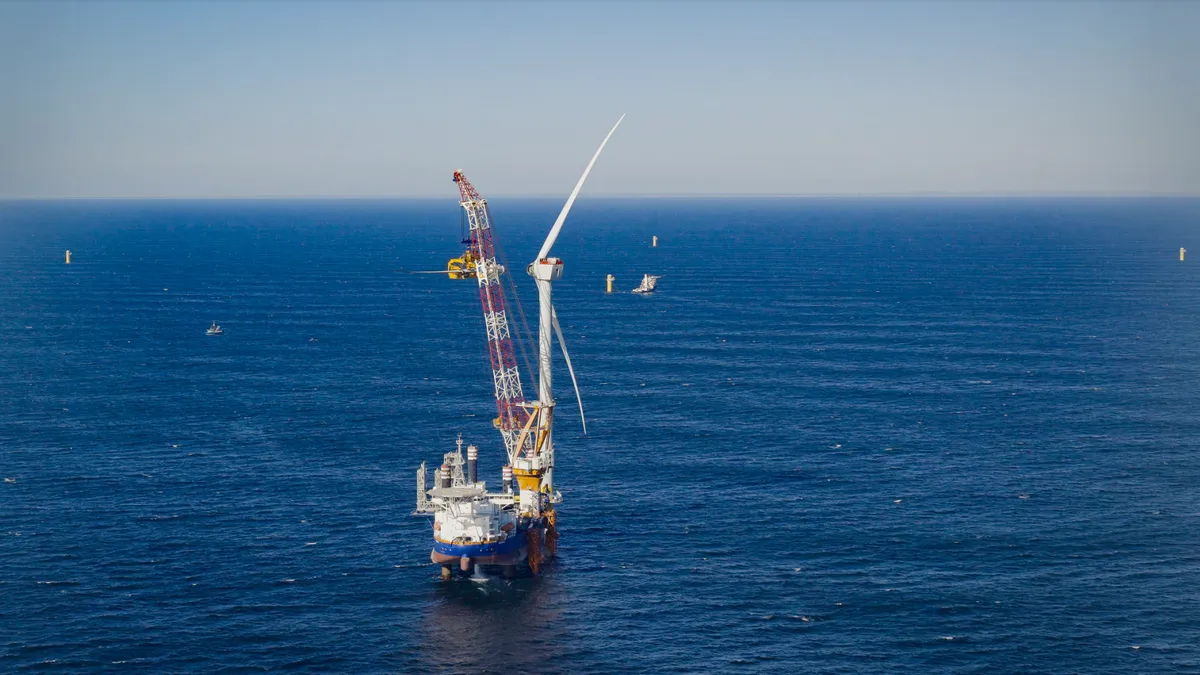Dive Brief:
- New York opened its fourth offshore wind solicitation today, with bids due Jan. 25. The submission process has been “significantly streamlined” since the most recent solitication, said the New York State Energy Research and Development Authority.
- Developers Ørsted and Eversource are “working toward” the goal of having their 130-MW South Fork Wind farm start to generate power in December and deliver power to New York by early 2024, said Karl-Erik Stromsta, a communications advisor at Ørsted.
- The project installed its first turbine last week, becoming the state’s first utility-scale offshore wind project to do so. David Hardy, CEO of Ørsted’s American operations, told E&E News on Tuesday that the farm could begin generating power by the end of the week.
Dive Insight:
“We anticipate all 12 turbines being installed by the end of this year or in early 2024,” Stromsta said in an email. South Fork Wind is being developed off the coast of Rhode Island, but will provide energy to New York once completed.
Anne Reynolds, executive director of the Alliance for Clean Energy New York, said South Fork Wind beginning to generate power will be a “really important milestone” for the state and the U.S. offshore wind industry.
Reynolds said in a Wednesday interview that the group was keeping an “eagle eye” on New York’s fourth solicitation and was seeking its expedited release. She said that if the state were to stand by its commitment to issue a request for proposals on Nov. 30, make a decision on the RFP in February, then issue another solicitation in 2024, “it's an excellent sign that New York is going to stay committed to growing this industry.”
“To allow for expedited preparation and review of proposal submissions, submission requirements have been significantly streamlined,” NYSERDA said in a Thursday release announcing the solicitation. “Bid fees have also been reduced,” and the RFP “provides flexibility for a variety of proposals.”
NYSERDA expects to award projects in February, and execute contracts in the second quarter of 2024.
The U.S. offshore wind industry has been undergoing financial turmoil for several months, with several project developers exiting their power purchase agreements in order to rebid the projects due to increased financial stress from inflation, supply chain disruptions and higher interest rates.
New York Gov. Kathy Hochul, D, dealt a blow to state developer Equinor last month when she vetoed an offshore wind transmission planning bill due to a dispute between Equinor and the city of Long Beach over the developer’s desire to temporarily take over city parkland in order to install a cable system to support the Empire Wind 2 project.
Ørsted announced last month that it would cease development on its two largest U.S. projects, Ocean Wind 1 and 2 in New Jersey. The company may have been “too optimistic” or “too aggressive,” Hardy told E&E News, but the progress on South Fork Wind is a “bright spot” for the industry, he said.
New Jersey Gov. Phil Murphy, D, who called the Ocean Wind cancellations “outrageous,” directed the New Jersey Board of Public Utilities on Wednesday to launch the state’s fourth offshore wind solicitation in early 2024.
Reynolds said that South Fork Wind’s progress is “fantastic news,” though it illustrates the lengthy amount of time needed to take an offshore wind project from proposal and bid to completion.
The lease area that South Fork Wind is being constructed in was first awarded as a commercial offshore wind energy lease in 2013 by the Bureau of Ocean Energy Management to developer Deepwater Wind, which was later acquired by Ørsted. The Long Island Power Authority recommended the project for approval in 2016, and construction on the farm began in 2022.
Like Empire Wind 2, South Fork Wind encountered “huge opposition” regarding the installation of onshore transmission cables, Reynolds said.
“The state maintained its commitment even in the face of that opposition, which was not well-founded,” she said. “And the fact that the project has come this far is great — especially right now. But it has illustrated that something this big, and this new, has a lot of bumps in the road, both economically and public acceptance-wise.”















